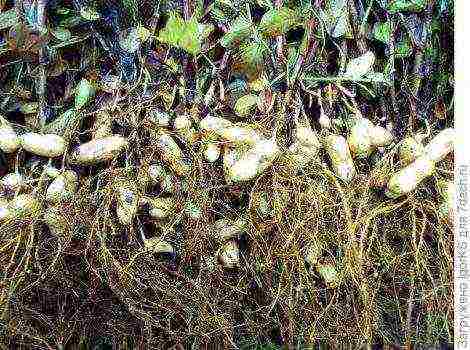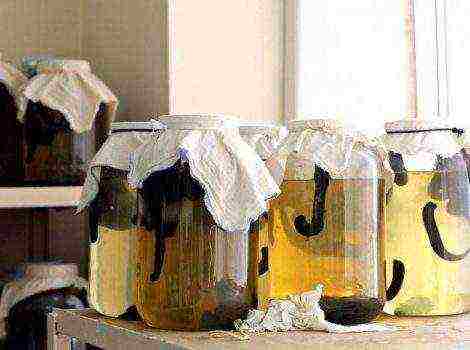Content
Already several centuries ago, people began to think about how to cultivate. The first attempts to cultivate ginseng were made in the Far East. Currently, the root of life is cultivated even in central Russia. The success of ginseng cultivation in central Russia is primarily determined by the creation of the desired microclimate, as well as light shading.
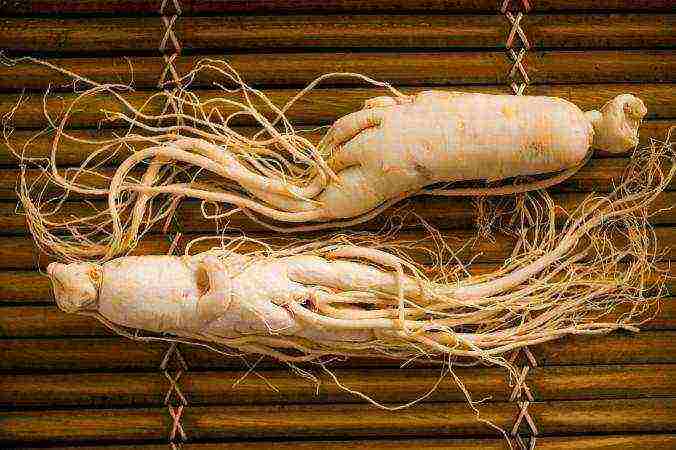
It is worth noting that with sharp fluctuations in air humidity, the plant becomes sick and may even die, therefore, the humidity must be maintained within 70-80%. To achieve this, beds with ginseng are placed between the trees, and sawdust is laid around them, which are watered several times a day in dry weather.
Soil for growing ginseng.
To grow ginseng, use the following soil composition: 2 parts of loose earth, 1 part of deciduous humus, 1/2 part of wood dust and 1/2 part of coarse sand. Add 2 tablespoons of wood ash to each bucket of the mixture. Rotted manure humus (5-6 kg per 1 m2) or peat-humus compost can be added to the above composition. To prepare deciduous humus, fallen leaves are collected in a heap in autumn, poured abundantly with water and periodically stirred to accelerate the decomposition process. Three times over the summer, fertilizers enriched with trace elements for indoor flowers are added to the humus.
Deciduous humus mixed with wood dust is used as the main part of the topsoil when laying ginseng beds.
Preparing the soil for planting ginseng.
Ginseng beds, no more than 1.2 m wide, are located from east to west. Over the entire area of the bed, a layer of earth is taken out to a depth of 20 cm, then the bottom is leveled, drainage is made (with a layer of 5-7 cm) from river gravel or coarse sand, and the beds are filled with the prepared soil mixture. The surface of the bed is leveled. 10-14 days after filling the beds with a soil mixture, preventive disinfection of the soil is carried out with a solution of 40% formalin in a ratio of 1: 100 (for 1 liter of 40% formalin, 100 liters of water). The consumption rate of the solution should not exceed 8 liters per 1 m2 of the garden. Soil cultivation is carried out from an ordinary watering can.
Planting ginseng.
Ginseng is propagated by seeds only. The latter can be purchased from amateurs or ordered at enterprises that grow this plant. The seeds are harvested when the fruit is fully ripe. To separate the seeds from the pulp, the fruits are mixed with wet, pre-calcined sand, kept for 3-4 days, then washed, mixed again with sand and left for 24 hours. After that, the mixture is sieved through a sieve, the holes of which are slightly smaller than the seeds.
The seeds prepared in this way are again mixed with sand (for 1 part of seeds 3-4 parts of sand), poured into a wooden box, closed with a wooden lid and buried in the ground to a depth of 30-40 cm. Once a month, the mixture is moistened.
In the above mode, the seeds are kept for 1 year. Stratified seeds are planted at the end of August. In the spring of next year, they usually sprout.
Before sowing, the seeds are disinfected for 15 minutes in a 0.5% solution of potassium permanganate, and then ventilated in the shade for several hours.
For planting ginseng, an ordinary method is used. The rows are placed across the beds with row spacing of 10 cm. Seeds are planted in rows at a distance of 5-7 cm from one another, embedded in the soil to a depth of 5 cm.
Immediately after planting, the beds are watered and mulched with humus with a layer of 1-3 cm.
Care of crops and plantings of ginseng.
Before the onset of cold weather, the beds on which ginseng seeds are sown are covered with fallen leaves with a layer of 10 cm or mulched with peat crumbs with a layer of 2-4 cm.
In the spring, about a week before the appearance of the first shoots, the insulating layer is removed, and shade canopies are installed over the beds, for the manufacture of which wooden shields with 2-centimeter gaps are used. Shields are made of boards 150-170 long, 12-15 wide and 1-1.5 cm thick. Care for seedlings consists in periodic weeding, loosening and moistening of the soil. 10 days after the emergence of seedlings, a preventive treatment of plants is carried out with a 0.01% solution of potassium permanganate (2 liters per 1 m2). A week later, re-treatment is done with a 0.3% solution of potassium permanganate (1 liter per 1 m2), and a month later the plants are sprayed again (1 liter of a 0.5% solution of potassium permanganate per 1 m2 of plantings).
Transplantation of ginseng seedlings is carried out in early October, after the aerial part of the plant has dried. The dug roots are placed in rows in an enamel container, the bottom of which is lined with a damp cloth or moss. Cover the roots with a damp cloth. The seedlings are planted on the same day. First, the roots are kept for 3-5 minutes in a 0.5% solution of potassium permanganate, then washed with clean cold water and dried in the shade for 15 minutes.
Prepared roots are planted with a slight slope in the grooves. The distance between the grooves should be at least 40, and between the plants - at least 20 cm.
The planting depth of ginseng should be such that the wintering bud is 4-5 cm from the soil surface. After planting the plants, the grooves are covered with soil mixture, slightly compacted, watered and covered with a 2-centimeter layer of leaf humus. After the onset of cold weather, the plantings are insulated, as a rule, with a 7-10 cm layer of sawdust. At the end of May, the plants sprout. Further care for ginseng consists in periodic watering, weeding and loosening of the soil, as well as annual preventive treatment of plants with a solution of potassium permanganate.
Often people run to pharmacies looking for medicines from the ginseng of the Far Eastern population. But you can grow ginseng in the garden or just in your apartment on the windowsill.
I solved the problem with this medicine for myself a long time ago: for more than 20 years now I have been growing ginseng in my garden and in an apartment. It turns out very well: ginseng in the apartment perfectly took root along with other medicinal plants: golden root, mordovnik, anise lofant. This fall I have harvested roots, one of which has grown to weigh 102 grams.
Everyone knows that ginseng is a very valuable medicinal plant. But not everyone knows that roots are used for treatment, which are collected in the fall only in the fourth year of his life.
Ginseng is used as a tonic for hypotension, loss of strength, exhaustion after severe illnesses, with decreased function of the gonads, female infertility, atherosclerosis, heart disease, anemia, diabetes mellitus, inflammatory liver diseases, gastritis, radiation injuries.
It's good in the taiga, but it's better at home!
IN indoor conditions ginseng grows much fasterthan on the plot or in the taiga, since I create optimal conditions for it: I maintain the relative humidity (30%) due to wet coniferous sawdust. I take into account that ginseng does not like excess nutrition - it grows decrepit, and dies from direct sunlight.
Ginseng is propagated by seeds, which I collect in September and place them in a cardboard box at the very bottom, and cover them with wet sand on top. I keep it in the refrigerator door for 21 months on stratification, and I moisten the sand as needed. In the spring in mid-April (almost two years later) I prepare the soil of the following composition: peat - 30%, leaf humus - 30%, sand - 10%, earth - 30%.
I sow seeds in pots with this soil to a depth of 5 cm.I put the pots on the windowsill, arrange shading from one layer of gauze. In spring and summer, I water the plants moderately, like indoor flowers, I loosen the ground to a depth of 2 cm.
In the fall, I put ginseng in pots in a wooden box, sprinkle it with peat and take it to the balcony for the whole winter, attaching pieces of film on top to protect it from water and snow. In mid-April, I put the ginseng in the room in its place.
Reference by topic: How to grow ginseng right on the site
A whole pharmacy
After four years, the roots can be used to prepare tinctures, decoctions, extracts, ointments. You can also prepare a powder from a dry root of plants, it is taken orally at 0.25 g at a time three times a day. I prepare the tincture in 50-60% alcohol in a ratio of 1:10. The dose is 10-15 drops per appointment. Ginseng roots insist on wines and cognac.
N. SEMELEV, Mordovia
Below are other entries on the topic "Cottage and garden - do it yourself"
How to grow your own ginseng - planting and care: Growing ginseng in the garden, on ... Ginseng plant - growing (watering and care soil): How to grow ginseng The idea of growing a new one ... How to grow ginseng - harvesting the root: Growing ginseng in the garden About healing ... Ginseng growing and planting care: personal experience: How to grow ginseng Ivan Lavrentiev from ... Growing and cultivating ginseng, caring for a plant, planting and photo: How can you grow ginseng in ... Herbs against autumn colds - herbalist's advice: What herbs to brew for colds Autumn ... How to grow ginger at home: Growing ginger at home Oh ...
Subscribe to updates in our groups.
Let's be friends!
4 parts: Selecting and planting a plant Seed preparation Planting seeds Caring for plants and harvesting
Widely used in herbal medicine for thousands of years, high-quality ginseng root is still expensive, and patient gardeners can reap bountiful harvests using the “simulated wilderness” method. According to the method described below, it takes about 7 years from the moment of planting the plant to the harvest of high-quality ginseng, and the likelihood of harvest dying is minimized. While ginseng can also be grown in the field under artificial shade in as little as four years, this method is much more effort and costly, and the result is much less valuable ginseng with limited uses.
Part 1 Selecting and planting a plant
-
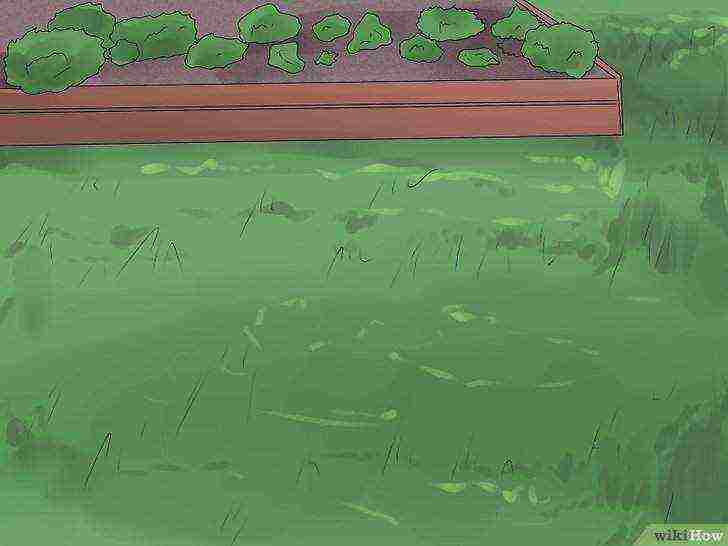 Learn how to grow a plant using the Wildlife Simulation method.
Learn how to grow a plant using the Wildlife Simulation method.
This method simulates natural conditions for a plant. While it usually takes eight years to grow ginseng in this way, the end result is a much more valuable plant, better in color and shape than its field-grown counterpart. You can influence this process by using artificial shade or by plowing the land, but then you will end up with forest-type ginseng, which can be transformed into a different, less valuable species.
- Growing in the field will take 4 years, but it will take a lot of effort, take into account the high risk of spreading disease and invest $ 20,000– $ 40,000 per hectare. Most smallholder farmers choose the method described in this article, which allows them to grow a more valuable plant and reduce costs to $ 2,600 plus labor. Please note that these are approximate costs.
-
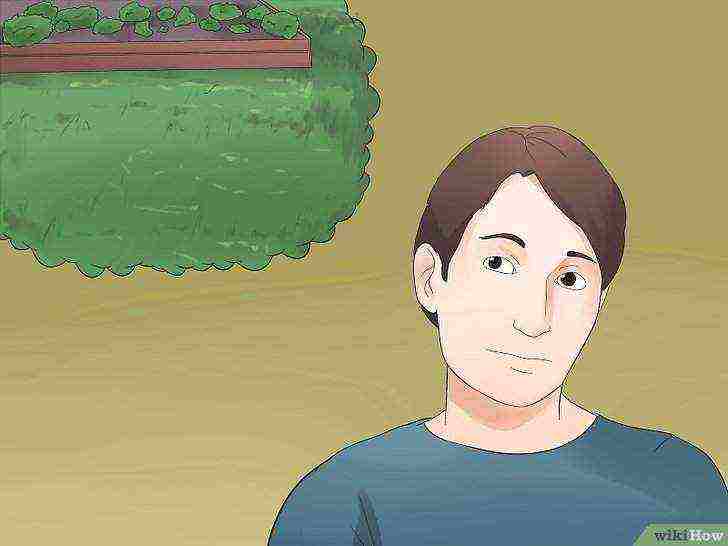 Find out if your climate is right for him.
Find out if your climate is right for him.
If you want to grow ginseng using the “simulated wilderness” method, you will need a piece of natural land to grow the plant. Ginseng grows in cool and temperate climates, in deciduous forests with an annual rainfall of 50-100 cm.
Such climatic conditions are typical for the regions of the northwest, midwest and northeastern United States, southern Canada and the mountainous regions of the southern United States of America.
- If you are not sure if ginseng can be grown in your area, look online, or contact your state or regional environmental office.
-
 Obtain all permits or licenses required to grow and market ginseng.
Obtain all permits or licenses required to grow and market ginseng.
The laws governing the cultivation of ginseng vary from state to state. Special permits or licenses are often required, especially if you plan to grow ginseng for commercial distribution. Research the laws in your area and contact your local service or state agricultural office or trade department to find out what you need to do to grow ginseng. You should also look into organic certification well before planting your seeds. The Wildlife Simulation method described in this article is organic.
- Of the 19 US states that are allowed to grow ginseng, 18 are allowed to harvest when the plants are at least 5 years old and have at least 3 leaves, while in Illinois the plant must be at least 10 years old, and it must have at least 4 sheets.
-
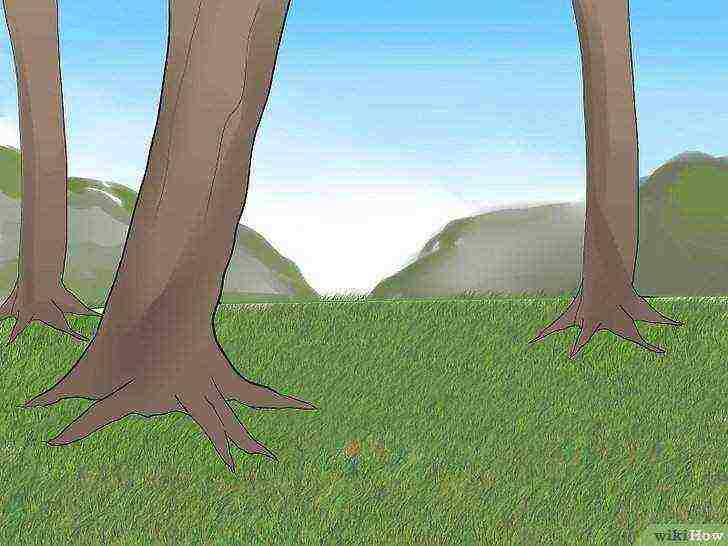 Choose the most suitable location.
Choose the most suitable location.
Ginseng grows best in areas with good shade (especially in the northeast or on slopes), moist deciduous forests, especially where deciduous trees have deep roots like yellow poplar, oak, sugar maple, or tulip poplar.
A mature forest with large trees and shade that absorbs at least 75% of the sunlight is ideal.
Shrubs, thorns, and other tall, dense plants can interfere with the plant and absorb most of the nutrients available, leaving very little for the ginseng.
- Probably the best way to determine if a plant is suitable for your region is to find wild ginseng in your area.
- Wild ginseng is extremely rare, you may also look for some "companion plants" such as trillium, cohosh, arizema, hydrastis, kupena, clefthoof, rattlesnake fern. Search online for photos of these plants and check which ones grow in your area, or ask your local botanist for help.
- Also, keep in mind that poachers are a major problem in harvesting ginseng: choose a location away from prying eyes, hiking trails, or the roadway.
-
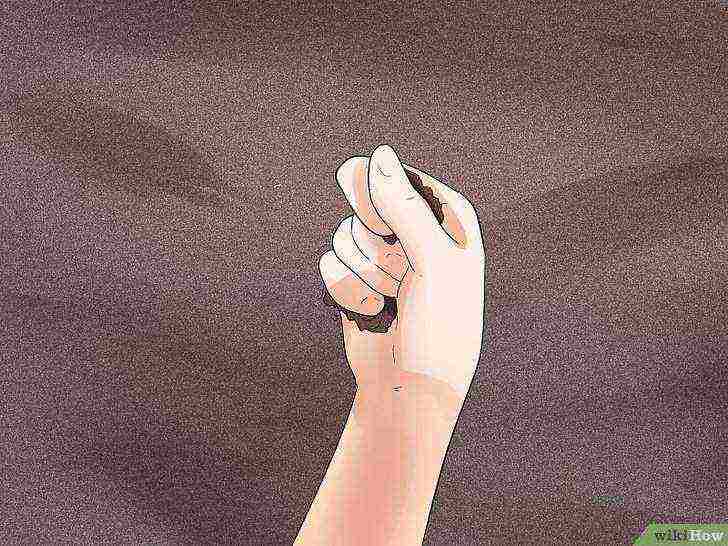 Evaluate and test the soil.
Evaluate and test the soil.
The soil should be loamy and moist, with good drainage. Avoid swampy soil and hard clay. If you already have a planting site in mind, take soil samples from different places in the area in equal portions and mix them in one plastic bucket. Do a soil analysis in a laboratory or university.
Horticultural stores sell kits for self-checking soil pH levels, but testing soil for calcium and phosphorus can be much more difficult. Despite different opinions about the most suitable soil, focus on pH values from 4.5 to 5.5 (acidic soils), calcium - about 0.35 kg per square meter, phosphorus (p) - at least 0.01 kg per square meter of land.
- Soil with the correct moisture level should stick to your hands or roll easily into a lump.
- Some growers believe that the pH level should be more neutral, between 6 and 7. Unfortunately, there is no definite opinion on how to determine the ideal habitat for ginseng, but it should grow in soil with a pH level in the range of 4 to 7.
-
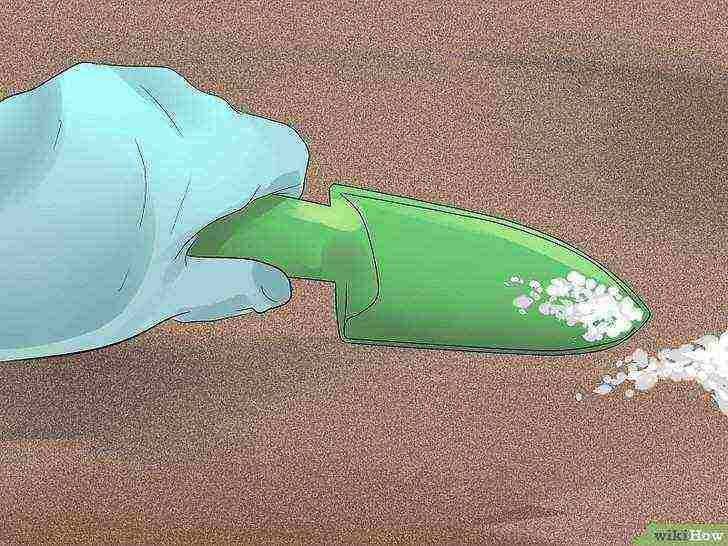 Feed the plants as needed.
Feed the plants as needed.
If you have found the ideal planting site in every way, except for the chemical composition of the soil, you can change the soil on the site to adjust the pH level or increase the saturation with phosphorus or calcium. If you want to sell simulated wilderness ginseng instead of forest species, avoid fertilizing, or at least apply a layer of fertilizer to the surface of the soil rather than mixing with the ground.The pH of the soil can be increased by adding lime (calcium carbonate). Also, the calcium level can be raised without changing the pH level by adding gypsum (calcium sulfate).
- Note that ginseng can grow in areas with a lower calcium or phosphate content in the soil, but this can slow down root growth and make them smaller. Try to plant the plants at a distance from each other so that they have enough nutrients in the soil.
Part 2 Seed preparation
-
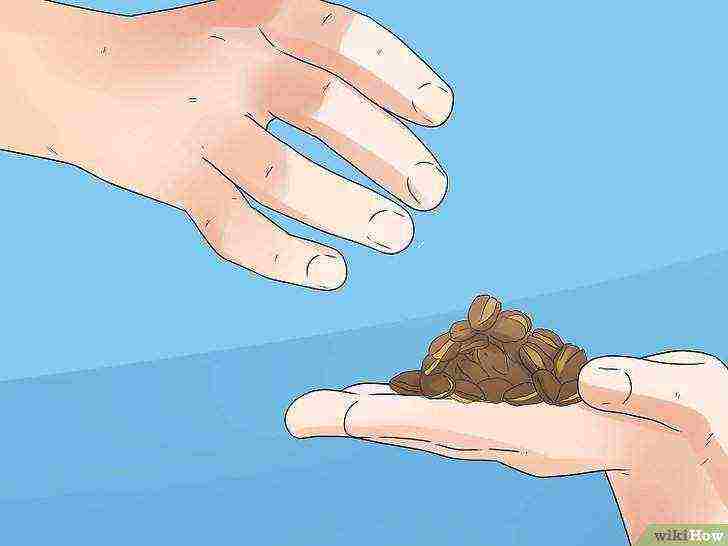 Buy or collect ginseng seeds.
Buy or collect ginseng seeds.
Please note that some regions have laws that prohibit or restrict the collection of wild ginseng seeds. Check the laws of your state, state, or region before looking for wild ginseng. If you are not legally allowed to harvest seeds, or cannot find this extremely rare plant in the wild, buy seeds from your local specialty store or order online. Green seeds will cost you less than cold stratified seeds, but will require several months of preparation, as described below.
- Soft, moldy or discolored seeds are not suitable for sowing. You may return them to your seller for a replacement.
- Order seeds in advance, in July or August, and get them by fall. If you delay the purchase until the fall, you run the risk of being left with the lowest quality seeds.
-
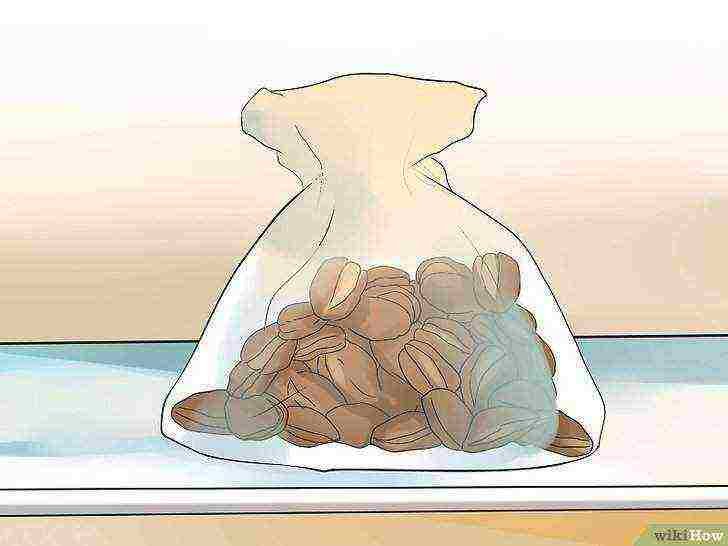 Keep seeds moist before planting.
Keep seeds moist before planting.
Store purchased stratified seeds in the refrigerator in a plastic bag. Spray the seeds with a spray once a week until planting. If the seeds dry out, they will become unsuitable for planting.
-
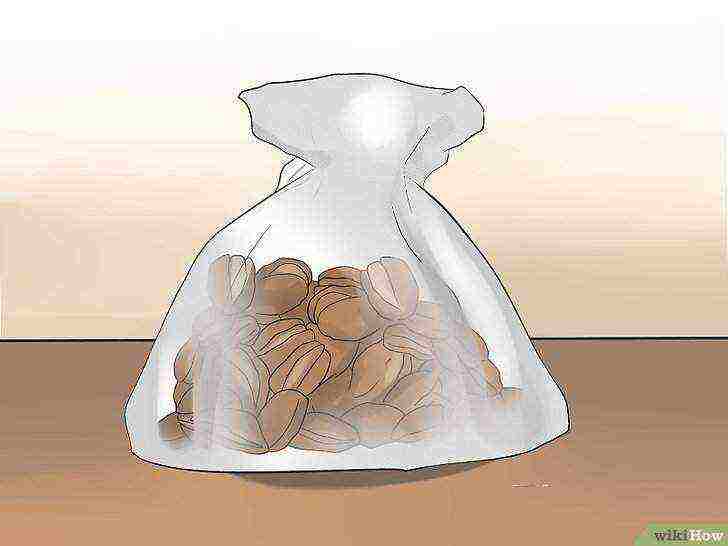 Prepare seeds for germination if they do not delaminate.
Prepare seeds for germination if they do not delaminate.
When ginseng leaves seeds in the wild, they do not germinate the next year. They need stratification throughout the year. This is the process by which the seeds are freed from the fruit pulp that wraps them around and stratified. Most of the ginseng seeds sold in stores are already layered, but if you picked them yourself or bought "green" seeds, you will have to complete this process yourself. Depending on how many seeds you have, use one of the following methods:
- Place some seeds in a lightweight wire mesh bag. In the fall, bury the 10–13 cm bag in loose earth in the shade. Cover with 10 cm of mulch. Mark this spot and keep the soil constantly moist, but not wet.
- If there are a lot of seeds, put them in a special container for draining the water and keep them away from rodents. Adjust a wooden box with a screen at the top and bottom, 20-30 cm deep if you have enough seeds for several layers. Fill it with alternating layers of wet sand and seeds. Bury the box 2.5–5 cm in the ground. Cover with mulch and make a note for yourself. Water when the soil dries up.
-
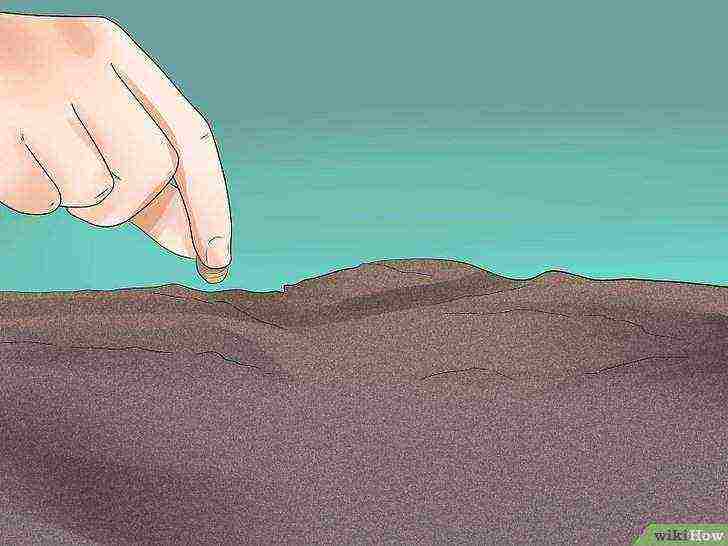 Plant the sprouted seeds in the spring.
Plant the sprouted seeds in the spring.
If you've stratified yourself, dig a box and check to see if the seeds have sprouted. Plant seeds that are soft, mildewed, or discolored. If any seeds have already sprouted, plant them immediately. Leave the rest in the container and bury again, stirring first and checking that the sand or soil is sufficiently moist.
-
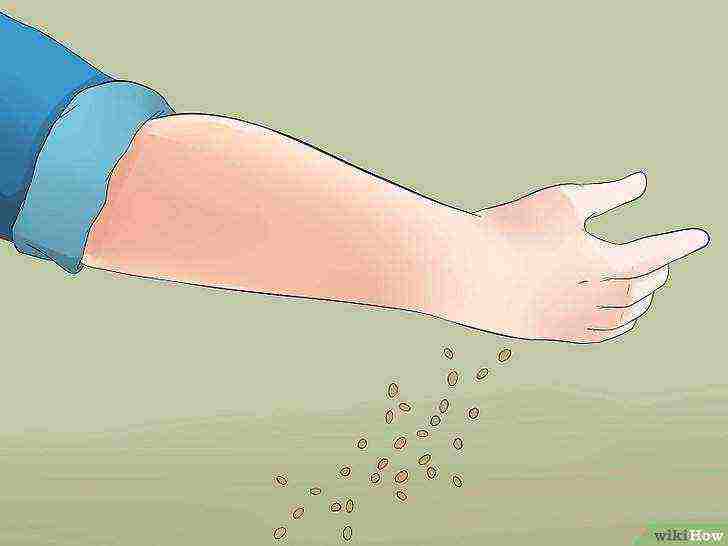
Plant leftover seeds in the fall. Most seeds should be planted in the fall, after the leaves have fallen from the trees but before the ground is frozen. Ginseng germinates best when seeds are planted in late fall or early winter, and this should be done when the ground is damp, like after rain.
-
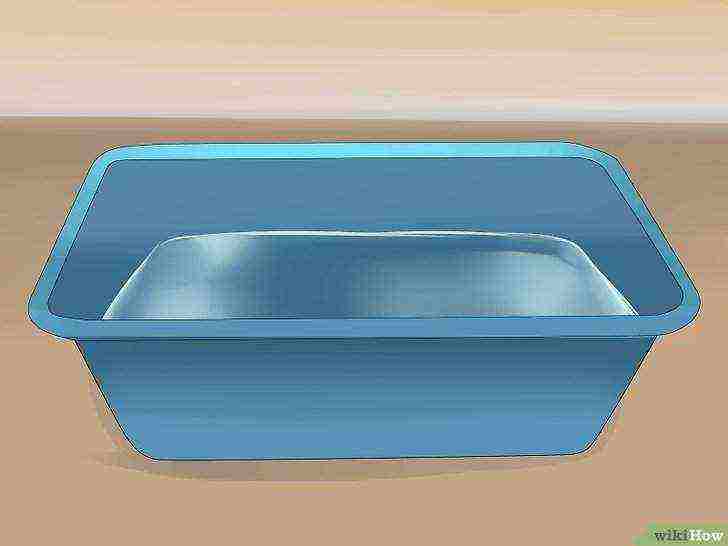 Soak seeds in bleach and water before planting.
Soak seeds in bleach and water before planting.
If your seeds are germinating, soak them in a 1: 9 mixture of household bleach and water.
Leave it on for 10 minutes to destroy the pores of the fungi that often infest ginseng seeds. The seeds that float to the surface are most likely empty and dead. They should be removed.Rinse the remaining seeds in clean water, and then take them to the planting site.
- You can also treat the seeds with a fungicide, but first make sure it is safe for the ginseng.
Part 3 Planting seeds
-
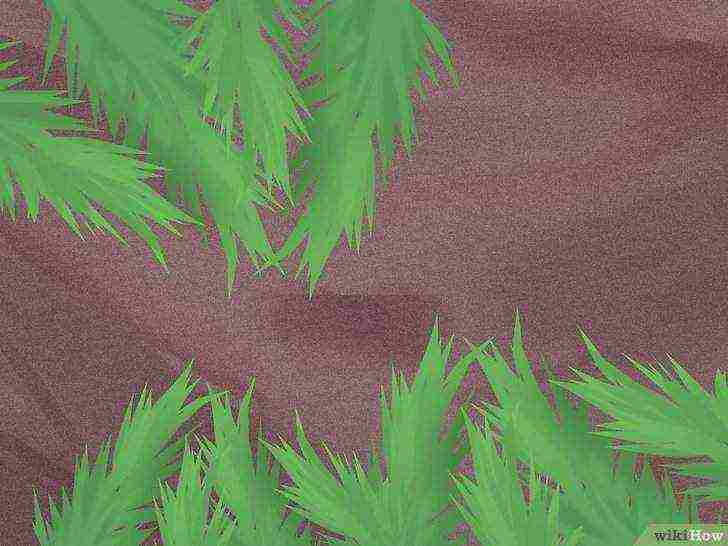 Clear the area of small weeds and ferns.
Clear the area of small weeds and ferns.
It is not necessary to remove all plants in the area, but excess vegetation will interfere with the growth of ginseng. Ferns, in particular, release a chemical that can kill nearby plants, so kill ferns or do not plant ginseng near them.
-
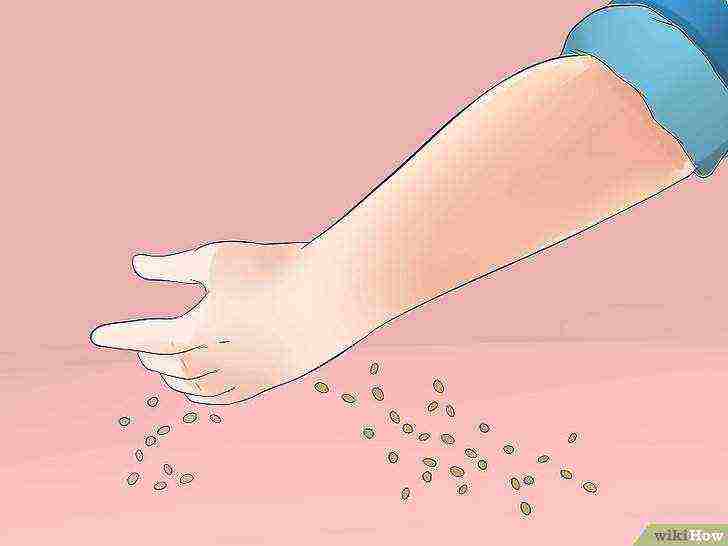 Plant large quantities of seeds quickly by scattering them.
Plant large quantities of seeds quickly by scattering them.
If you want your ginseng to grow in the wildest conditions possible, or if you have a lot of seeds, you can simply scatter them at your chosen planting site. First, remove fallen leaves from the ground. You should sprinkle 65-120 seeds per square meter.
-
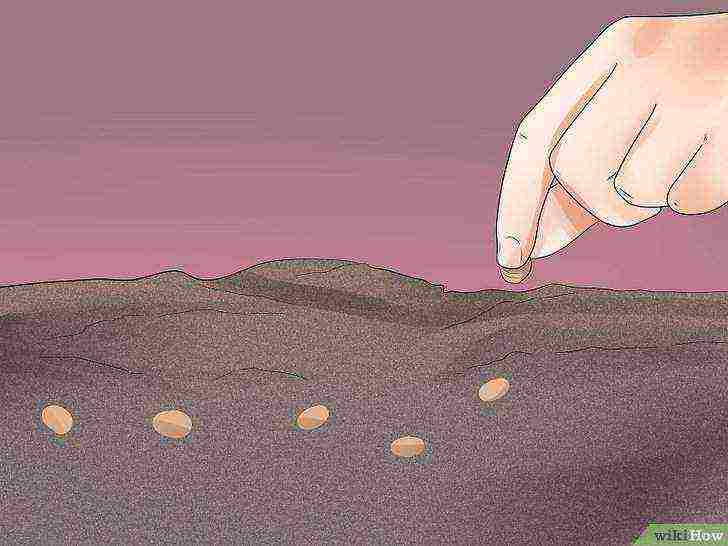 Plant seeds in smaller portions more thoroughly.
Plant seeds in smaller portions more thoroughly.
Even the wildest varieties require preliminary preparation and special tools for planting. First, rake the fallen leaves off the ground. Use the glanders to make furrows along, not downhill. Plant as needed:
- Plant the seeds 15-23 cm apart if you plan to grow a large seven-year-old ginseng plant. This is a typical wild-type planting method for ginseng, as the wide margin reduces the risk of disease spread.
- Plant them at least 1 inch (2.5 cm) apart if you have a lot of seeds and want to harvest early. This method is more commonly used for field varieties of ginseng, as in densely planted areas, ginseng should be well looked after, diseases and pests should be fought. This method is not recommended for those who are doing it for the first time.
-
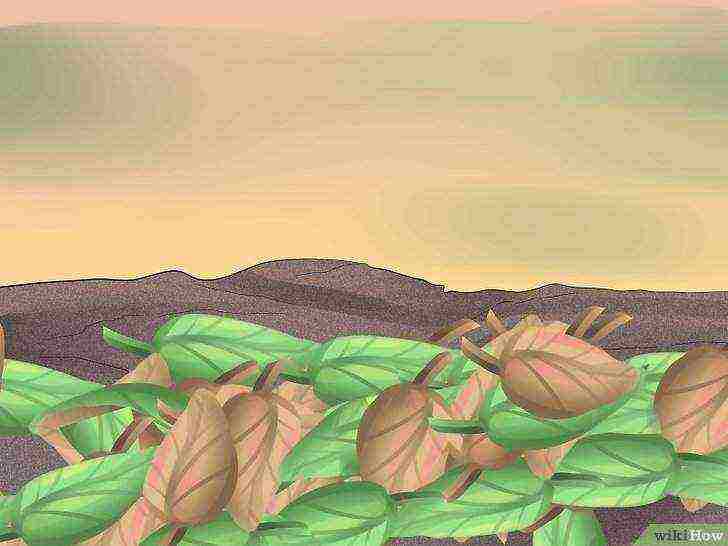 Cover the area with leaves or mulch.
Cover the area with leaves or mulch.
Bring back the fallen leaves you removed or add a layer of mulch. This will keep the soil moist, which is vital for ginseng. Apply a layer of mulch no more than 2.5–5 cm thick, otherwise the ginseng sprouts will not be able to break through the thick layer of mulch. If you live in an area with cold winters and frequent frosts, use 10 cm of mulch, but remember to remove some of the layer in the spring.
- Do not use whole oak leaves for this purpose. They are too tough and will interfere with the germination of the seedlings. Chop them up if you bought oak mulch.
-
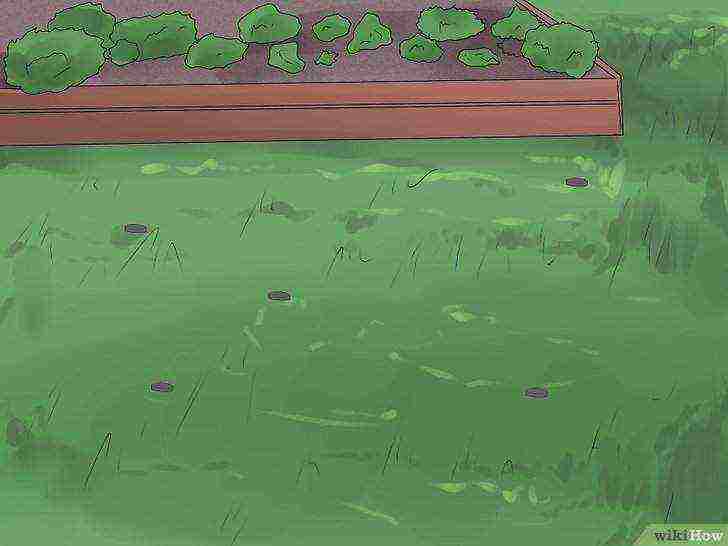
Mark the landing site or save the coordinates in GPS format. You don't have to pay much attention to this area, and the forest can change a lot in seven years or more, so make sure you can find the plant. The best way to memorize a location is to use a GPS device to determine the exact coordinates of the site. Thus, you do not have to make any markings that would attract the attention of poachers. If you do have to make a mark on the site, try not to make it too flashy.
Part 4 Plant care and harvest
-
 Keep the place secret and secure.
Keep the place secret and secure.
Poachers often scurry about in areas where ginseng is grown because of its rarity and value. By enclosing an area, you will not hide the ginseng, but people will not enter the area.
A bull, dog, or other aggressive animal can be an excellent guardian if you fence off the plant from the animal.
-
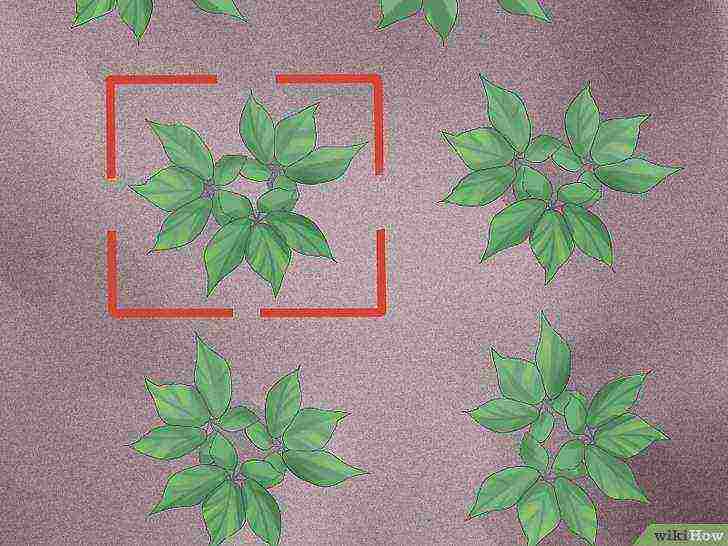 Thin your planting every year.
Thin your planting every year.
Plants that grow too close together can carry disease or take nutrients from each other. Consider pruning or replanting your plants after your first growing season to get 65 plants per square meter. After the second year, leave 11-22 per square meter.
- You can also plant ginseng in different areas each fall to ensure consistent harvests. Many gardeners do this in order to get the first crop of mature ginseng only after the first batch is ripe.
-
 Study the issue carefully before using pesticides and poisoning pests.
Study the issue carefully before using pesticides and poisoning pests.
One of the main advantages of the method of "simulating the conditions of the wild" is considered to reduce the risk of damage to plants by pests and diseases due to the large interval between them. In addition to the fact that some mature plants or berries can be eaten, take care of valuable roots as well. Diseases should not spread quickly between plants.
If you have problems, contact your local wildlife office for information on pesticides for ginseng.
- Be aware that you risk losing your certificate to grow or sell wild ginseng if you use pesticides.
-
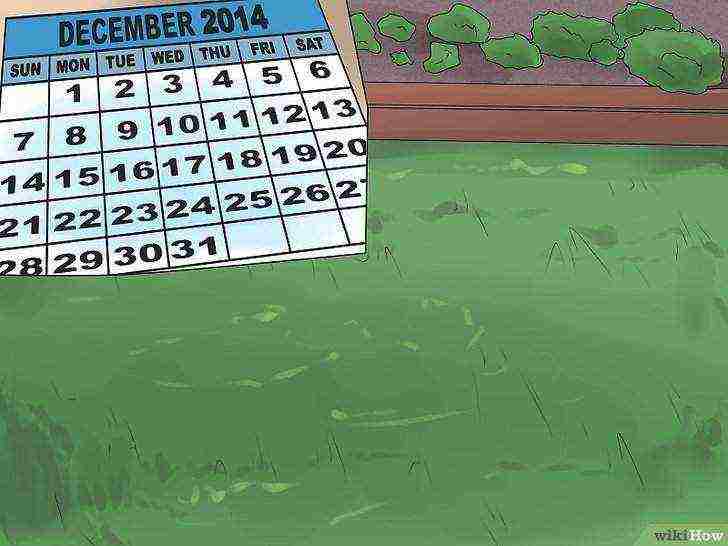 Wait for the plants to mature.
Wait for the plants to mature.
You will have to wait about 7-10 years for your seedlings to grow large and their roots are valuable, but in the right place and in the right circumstances. Cultivating ginseng using the “simulate wildlife” method requires a lot of patience, but hardly any maintenance. Check periodically to make sure the ground is damp and covered with a small amount of leaf litter.
- If your ginseng is growing densely, harvest after 4 years, otherwise the roots will begin to deplete and lose their value.
-
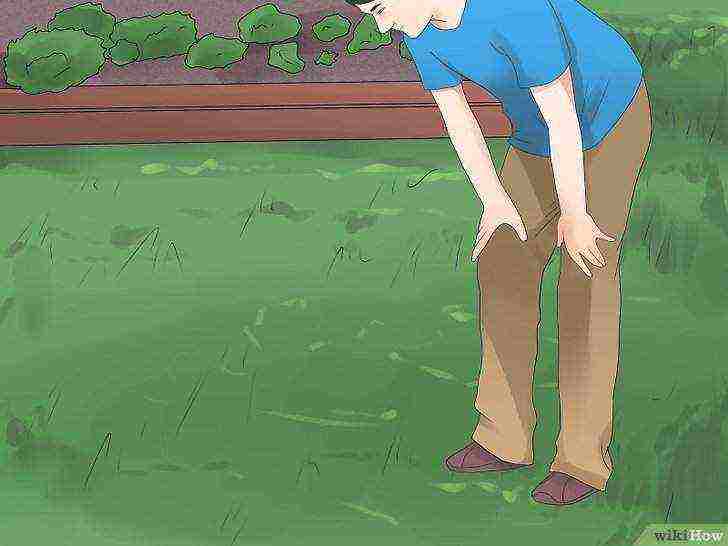
Don't rely on plants to be visible all year round. Some plants die on the surface in the fall and germinate again in the spring. With each new season, the plant will get larger, and the roots underground - more and more.
-
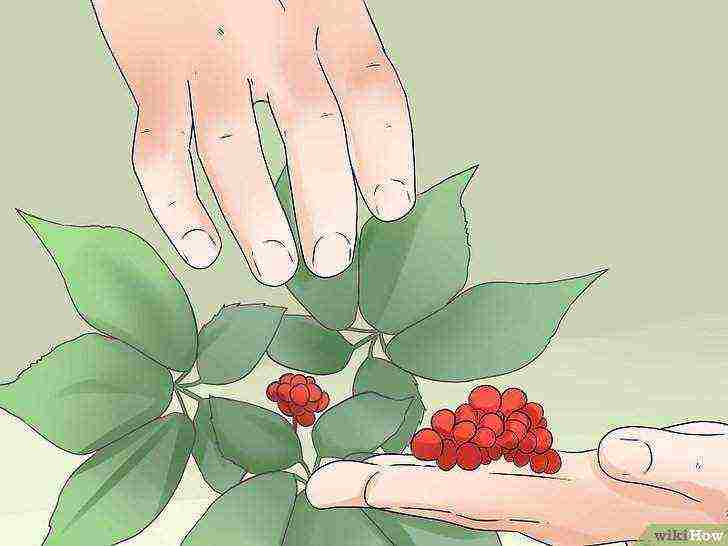
Harvest red berries after your third year. As soon as the plant is ripe, berries with seeds inside will appear on it. Collect seeds for planting or for sale during the fall season. Keep in mind that they should be stratified as described in the Seed Preparation section.
-
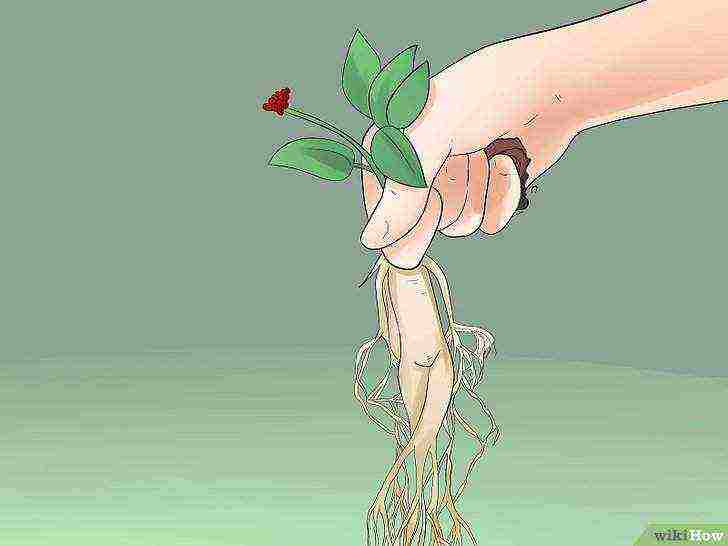
Harvest mature plants any time after seven years. Given how long it takes to grow ginseng, you will most likely want to use a quality mature root of the plant after 7 years. If you are not in a rush, you can leave the plants in the ground where they will continue to grow for many more years. If you are in a hurry, check your local laws and find out how long it takes to start harvesting ginseng root.
-
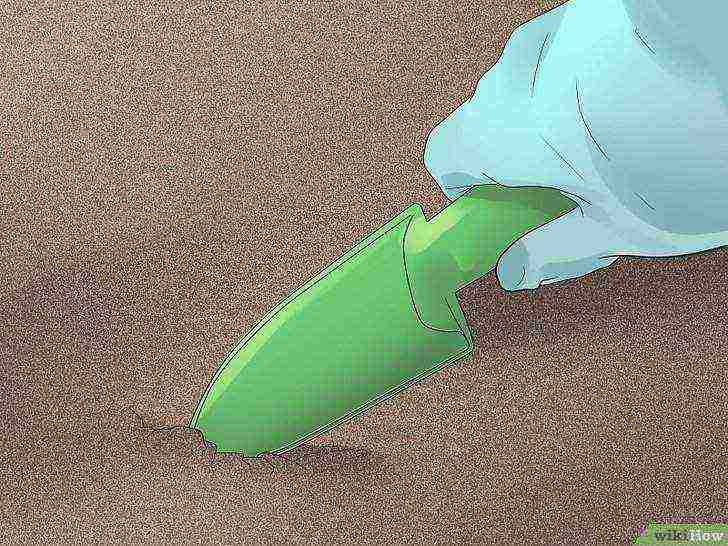 Dig carefully so as not to damage the root.
Dig carefully so as not to damage the root.
Use a rake or a pointed shovel to dig under the plant and back out far enough (about 15 cm) from the root to the shovel. If the desired plant is close to others that are not yet ripe, use a smaller inventory, 20-25 cm long, and work with extreme caution. If there is a risk of damaging the roots of nearby immature ginseng plants, do not try to dig it out until other seedlings are ripe.
- Consider: Ginseng usually grows at a 45 degree angle, not straight down, and splits into multiple pieces. Dig carefully so as not to damage the root.
-
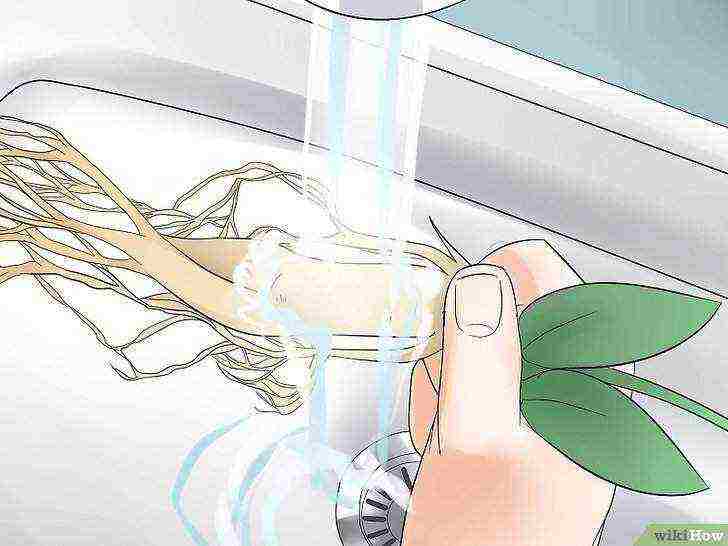 Wash and dry the roots.
Wash and dry the roots.
Leave the roots in a bucket of cool water for a while to scrub them off the ground. Then, place the roots in a single layer on a wooden pallet and wash them gently under a sink or hose. The roots should not touch. Let them dry in a well-ventilated area at 21–32 degrees Celsius. The humidity should be between 35 and 45, otherwise the roots will dry out too quickly and lose their value.
Turn them over once a day. The roots are ready when they burst when cut. Choose one root to check.
- Do not rub or wash the roots too vigorously - some medicinal chemicals concentrate in the root hairs, removing which will diminish the benefits of the root.
- Small roots dry in a day or two, but large, mature roots can take up to six weeks to dry.
- Direct sunlight will usually dry them out too quickly, but will kill unwanted mold infections and discoloration of the roots.
Tips
- Proper seating helps prevent the formation of fungi and disease. While some diseased plants may die, others will remain healthy, and if planted too close, they will most likely not survive. Companion plants such as yellow root can also reduce the likelihood of pests and diseases. If the spread of the fungus becomes difficult to control, contact your local agricultural office for advice before using the fungicide.
- Once your plants start bearing fruit, they will saturate your plot with seeds every year, so you can have a steady crop. If you want to ensure a consistent crop, you can add seeds in the first and second year, when young plants are unlikely to bear fruit.
- With a normal reindeer population, your crop is unlikely to be in any danger, but you can get guard dogs if reindeer are a problem in your area. Burrowing mammals generally won't be a big deal, but if absolutely necessary, use traps (not poison) and other natural deterrents.
Warnings
- Beware of cheap seeds. Collecting and stratifying seeds is a laborious process that requires additional maintenance. Responsible suppliers are doing everything right, but the price of seeds is appropriate.
- Given the risks of crop failure, poaching, or falling prices, you shouldn't invest all your savings in growing ginseng. Consider this prospect as an additional income or as a hobby in retirement, but you should have another source of income in case of failure.
- To ensure the survival of the species (and not to pay fines and go to jail), always comply with your state's laws regarding wild-simulated ginseng cultivation.
- Be careful if you run into poachers and don't use force.
Article Information
Categories: Gardens and vegetable gardens
In other languages:
English: Grow Ginseng, Español: cultivar ginseng, Italiano: Coltivare il Ginseng, Português: Cultivar Ginseng, 中文: 种植 人参, Deutsch: Ginseng anbauen, Français: faire pousser du ginseng, Čeština: Jat vypěstia العربية: زراعة الجنكة الصينية, Nederlands: Ginseng kweken, Tiếng Việt: Trồng Nhân sâm
- Edit
- Write a letter of thanks to the authors
This page has been viewed 9,755 times.
Was this helpful?
The cultivation of medicinal plants for sale to pharmaceutical companies is practiced by many Russians, from gardeners to owners of large farms. It is usually not difficult to find sources of sale, because there are less and less wild-growing raw materials in nature. With good reason, all this can be attributed to ginseng. On average, you can get from 4 thousand rubles per year per square meter, respectively, a hundred square meters, which can be allocated for a business for growing ginseng on any personal plot, brings a very decent income.
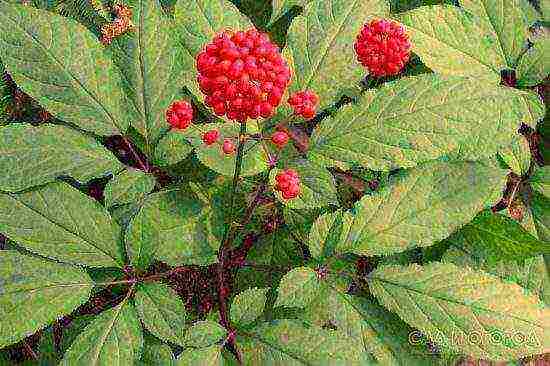
The value of ginseng
The need for ginseng root is consistently high: in the wild in Russia, it is found in the Far East, but since this plant is listed in the Red Book, its collection is punishable by law.
The tradition of using ginseng as the best adaptogen - an anti-stress agent in a broad sense - came from the East. Now the root of this plant is widely in demand in Russian developments: the leading pharmaceutical enterprises are located in Moscow, St. Petersburg, Vladivostok, Yaroslavl, Tver, Tomsk, Krasnodar, Rostov-on-Don, as well as in Ukraine and Belarus. In the West, companies in Austria, Switzerland, Slovenia, Germany, Denmark, the Netherlands, and the USA are engaged in ginseng. China and Japan have their own plantations, they supply their products to Western countries, so Russian businessmen have to limit themselves to the domestic market, which is also in great demand. The prospects for small business are obvious, because large ginseng plantations are found only in the Far East.
Ginseng cannot be called too capricious, but it has its own characteristics of cultivation. The climate of the Far East, the South of Russia and the Central Non-Black Earth Region suits it.Agrotechnology is not particularly difficult, but the period of plant development until the time of collecting the root is very long. Only in 2-3 years after the organization of the business it will be possible to sell seedlings, in another year the seeds, and the roots will acquire a marketable appearance in 5-6 years.
Land preparation
Under natural conditions, ginseng grows on the northern slopes; during cultivation, it needs protection from direct sunlight. Usually, wooden shields are adapted for this.
Soil preparation should be started with the season preceding planting. Ginseng prefers neutral loamy or sandy loam soil, loose, rich in nutrients. The costs should include the purchase of rotted manure (4-5 years old, otherwise the plants will "burn"). Many people also add phosphate rock, an inexpensive mineral fertilizer that does not harm the environment. Topsoil from deciduous forests can be used instead of manure in small areas.
Ginseng is extremely sensitive to pests and weeds, so large farms treat the soil a year before sowing or planting seedlings with pesticides. Gardeners do this by hand, sometimes with a formalin solution, and watered with a solution of potassium permanganate before planting.
It is known that the cultivation of ginseng greatly depletes the soil, therefore, it is necessary to provide for the possibility of changing the site after digging up the grown roots.
Purchase and planting of seeds and seedlings
Ginseng is propagated by seeds. In laboratory conditions, successful attempts were made to divide, but the quality of the resulting plants did not correspond to GOST. During storage, the seeds dry out quickly, therefore it is recommended to purchase them in the sand, ready for stratification, immediately after ripening - in September. The cost of one seed is 10-20 rubles. About 300 seeds will be required per square meter, followed by thinning.
Ginseng seeds germinate in the second year. To save time, farmers purchase seedlings at approximately 25 plants per square meter. The cost of 2-3-year-old ginseng starts at 100 rubles.
Obviously, planting material will not come cheap. It is possible that, despite all efforts, the soil and conditions will not suit the Far Eastern guest and seedlings will not appear, and the seedlings will die. In this regard, it is recommended to devote one year to trial plantings so that the cultivation of ginseng does not become ruinous for the entrepreneur. The seeds are stratified - for 4 months they are kept at constant humidity in a mixture with sand (20 ° C), pretreated with a solution of potassium permanganate, and then another 4 months at 0 ° C (it is possible in the refrigerator). Maintaining a constant, even temperature also requires additional costs.
Seedlings are planted outside the growing season, preferably in early spring. The roots are disinfected in Bordeaux liquid. Plants tolerate light frosts without shelter. The soil between the plants is mulched with humus or crushed bark to protect it from weeds and pests and at the same time retain moisture.
Caring for ginseng before maturity
Ginseng needs watering during dry times and regular loosening, as well as weeding if necessary. If the plant dies, it is removed, and the vacant space for disinfection is sprinkled with ash.
Plants are often attacked by the larvae of the click beetle and the May beetle. In large farms, they are fought with by spraying the plantings with pesticides, in garden plots - with solutions of ash or garlic.
Mice are not indifferent to seeds, so the beds are often surrounded by a metal mesh buried in the ground to a depth of 30 cm (the average depth of mouse passages).
Planting must be fertilized annually: they use rotted manure or leaf humus.
For the winter, in case of frost, the beds are covered with a 5-6 cm layer of leaves.
Collection, storage and marketing of crops
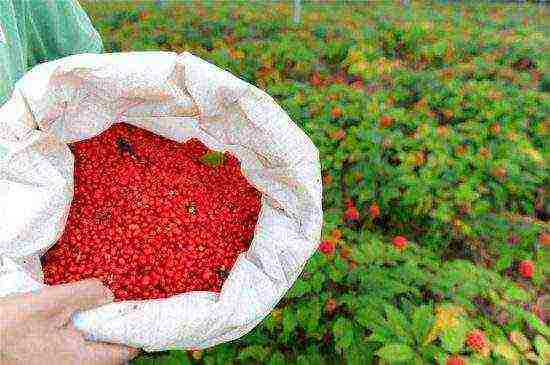
In the fourth year, ginseng blooms and gives seeds - 30-50 pieces per copy. They ripen in late August - early September.They are poorly stored, so they are either planted in the same year, or sold, after mixing with sand and not allowing them to dry.
At 5-7 years, the roots reach standard sizes of 40-60 g, sometimes up to 100. They are dug up, carefully cleaned of the earth, dried in the air and sold.
There are two ways of selling: firstly, to sell in bulk to pharmaceutical companies or resellers, and secondly, to sell to the same representatives of small businesses or simply to amateurs at retail - in horticultural markets or via the Internet. It is more profitable to use both options.
Some farmers, at their own peril and risk, open their own production of medicines - tinctures, powders, extracts, balms. Of course, this will require licensing efforts, but the finished product, of course, can be sold at higher prices than raw materials.
Return on production
As can be seen from the above data, the main costs of growing ginseng are associated with the purchase of planting material, preparation and fertilization of the soil. In large farms, this must also be supplemented by the cost of renting and mechanical processing of the land.
The minimum period from planting to the first income is 2 years (subject to planting of plants in the form of seedlings and the sale of seeds).
A one-time arrangement of beds on at least one hundred square meters of land will cost about 300,000 rubles - the amount available to already developed farms that successfully grow other agricultural products. This option is not suitable for starting a business from scratch. Here it is better to act in stages: to purchase a certain amount of seeds and seedlings, to sell part of the seed crop, and to sow part of it. So the area will gradually expand. Alternatively, cultivate ginseng in parallel with other medicinal plants with a shorter payback period.
Growing ginseng is beneficial for summer residents who are in no hurry: they can start with several copies, and then create a source of decent income for themselves on one hundred square meters. This is especially suitable for those who are planning to retire in a few years: you can have time to prepare a "plantation", and then devote the freed up time to work with plants.
So, the main conclusion: growing ginseng is an affordable and highly profitable activity. However, full payback can be achieved only in 5-7 years. Accordingly, it is necessary to take care of parallel sources of income for this period.
Latest news

